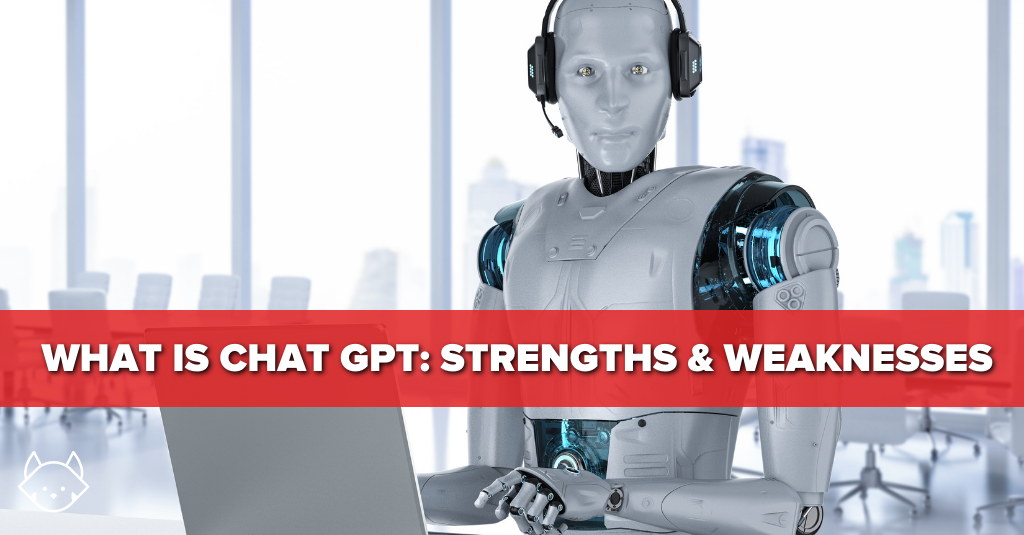ChatGPT is taking the internet by storm, with millions using the AI. ChatGPT can be used to have a positive impact on business, helping to reduce time that marketers and business owners spend on content creation. However, it also comes with its own set of limitations and it’s important to be aware of these. In this article, we’re going to give you a primer of the strengths and weaknesses of ChatGPT and show you how you can use this AI to its fullest potential.
You’re spending countless hours (or paying someone else to spend countless hours) on writing copy for social media posts and captions, blogs, and email marketing content, website and landing page copy, product descriptions, and reviews, scripts for videos and podcasts, advertising copy, and more.
But what if you could automate all of this and spend more of your precious time on tasks that generate revenue, like sales? That’s where AI-Generated content like ChatGPT comes into play.
In this article, we’re going to take a look at:
What is ChatGPT?
ChatGPT seems to be all everyone is talking about right now. For those living under a rock: ChatGPT is a free chat-bot style tool that uses artificial intelligence (AI) and machine learning to generate text that mimics human language. It’s based on a model called GPT (Generative Pre-trained Transformer) and has been trained on a large amount of text data so it can understand and generate text that sounds similar to how a human would sound.
This makes it very powerful because it can on some levels replace a human, helping with various copywriting tasks such as blog writing.
What’s even more exciting about ChatGPT is that you can talk to it, teach it, and help it improve, as if it were a real team member. Crazy, right!?
What do I mean by this exactly? Well, let’s say you’re creating social media posts, and you’re using ChatGPT to help you create the structure for your copy. In the first instance, you might tell ChatGPT something like “Write a social media post about how ChatGPT is going to change the marketing industry”. And, it might spit something out like this:

But if you’re anything like me, you want emojis in your social media post to break up the content a bit, and you like paragraph spaces between each sentence or so, and you might want to include a specific set of hashtags at the end of the post. We can tell ChatGPT that this is what we want moving forward. Let’s look at what a conversation like this might look like.

Now I may not be completely happy with this post, and I might have to edit it to match my expectations, but there are two things to keep in mind here:
- Although I have to make edits and add my own flavour, it has now shaved the amount of time I need to spend on this considerably!
- In the above example, I taught ChatGPT how to write a better response, and it worked. If I could teach it to improve from the initial response, I can also teach it to improve from this response. In fact, perhaps it is possible to teach it so that I won’t have to edit this at all.
This learning aspect is one of the things that differentiates ChatGPT from other AI writing-based software already on the market. What’s even cooler about this is that ChatGPT remembers the conversation, so I won’t have to remind it to follow these suggestions everytime because it has now learnt to do this when interacting with me.
Let’s answer some basic questions about ChatGPT.
How fast is ChatGPT in coming up with a response?
The responses don’t instantly appear, but it’s still insanely quick. From my own testing, I’ve seen that depending on the complexity of what you’re asking for, it usually takes anywhere between less than one second and up to five seconds to start responding (generally it’s less than one second). Once it starts responding, the text generates pretty quickly, but not all in one instant.
Here’s what it looks like:
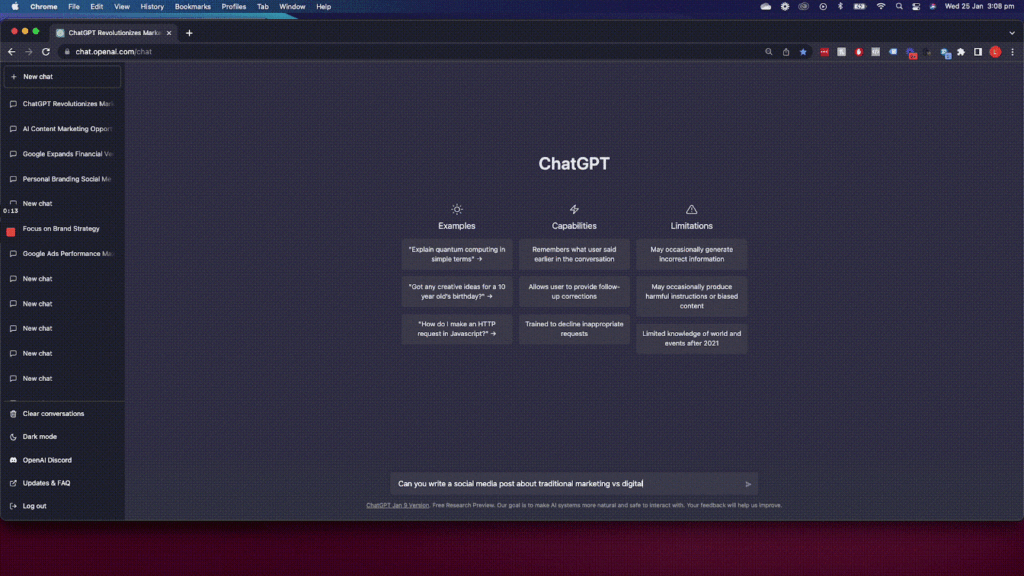
How smart is ChatGPT?
ChatGPT is extremely intelligent in the sense that it can answer just about anything. The software has access to information on the internet up till 2021, which makes it very smart. Whatever you want to ask, ChatGPT will have an answer for you (in fact, I’d be surprised if you could think up a question that it couldn’t answer!)
Where ChatGPT falls short in its intelligence is in its ability to understand emotion or use personal experience and context to craft responses. For example, you might find it difficult to discuss morality with ChatGPT, because its responses are based on the knowledge it gathers from the web, which it spits out in a way that mimics a human.
As a result, ChatGPT can be extremely advantageous because of its vast knowledge and ability to package that knowledge into text which sounds human. However, we may be presented with problems when we want to appeal to human emotion, or when we want to use our personal experiences to write something.
It’s smarter than humans in some ways, and we’re smarter than it in some ways. Perhaps working together is the key.
What are the Limitations of ChatGPT?
At the moment, these are the limitations of ChatGPT:
- Knowledge is limited to 2021
- Not capable of consciousness
- Its understanding is limited
- Grammatical errors and logic errors
- It is unable to provide sources
- It’s trackable and may negatively impact SEO
Knowledge is limited to 2021
If you’re working in a field that requires up-to-date information, ChatGPT will not be able to help you.
For example, if you’re trying to write an article about the newest camera trends in 2023, ChatGPT will write the article with the correct date, but it will ultimately deliver inaccurate information because it doesn’t know which cameras are trending in 2023.
As a result, ChatGPT is not dynamic, and this may prove difficult when we’re trying to write content that is up to date-with current trends, knowledge, and schools of thought.
Not capable of consciousness
While ChatGPT sounds human, it is not capable of consciousness, emotions, self-awareness, or personal experience.
As a result, it can’t make decisions or have personal opinions or beliefs. You might think this is a good thing, but it actually acts as a limitation more than anything else.
Since it doesn’t have any beliefs, it doesn’t have any preferences or biases that could influence its responses. This means that its responses will be based on the knowledge it pulls from the web and the training it has undergone.
On top of that, the model cannot make judgment calls or decisions, which means it can’t choose between different options or make a decision based on certain criteria.
In my personal experience, this makes it really hard to write blog articles with ChatGPT because the articles always lack an opinion, which is a necessary aspect of article writing.
Finally, these limits mean that ChatGPT cannot respond to emotional questions or respond in an emotional way. As a result, while ChatGPT does have the ability to write creatively, it is limited in its ability to speak to human emotion.
Let’s take a look at an example of ChatGPT struggling with this. I asked ChatGPT to write me a social media post about why people with dementia need to be cared for. Here’s what it responded with:
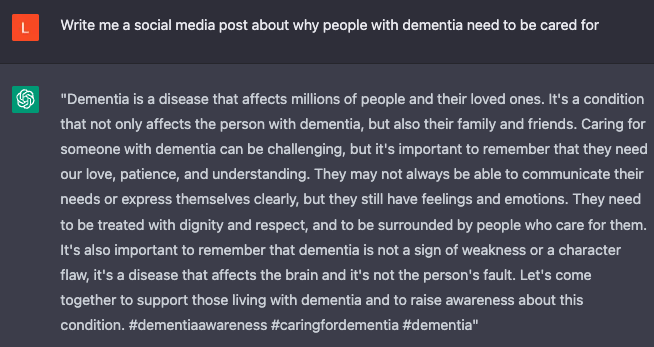
It’s not necessarily a bad answer per se, but it isn’t emotional. So, I tried again, asking ChatGPT to rewrite it with an emotional tone, and here’s what I got:
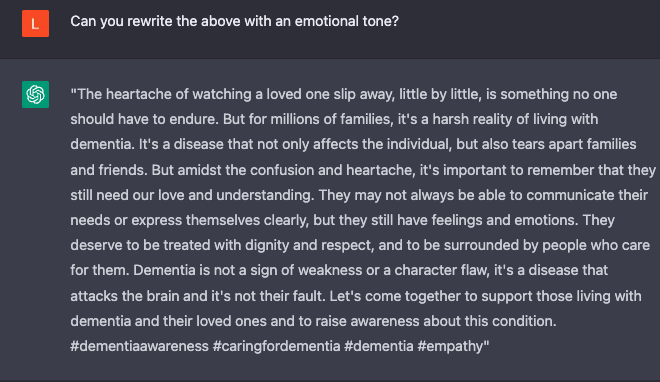
No doubt this one is far more emotional, however, its tone makes it sound as if it doesn’t feel the pain itself. When we want to really amp up emotion, we have to feel the pain ourselves, and this becomes evident in our writing. Using first-person language and including personal experiences is one way in which you can do this. So, I asked ChatGPT to do just this, to see how far I could push it, and here’s what I got:
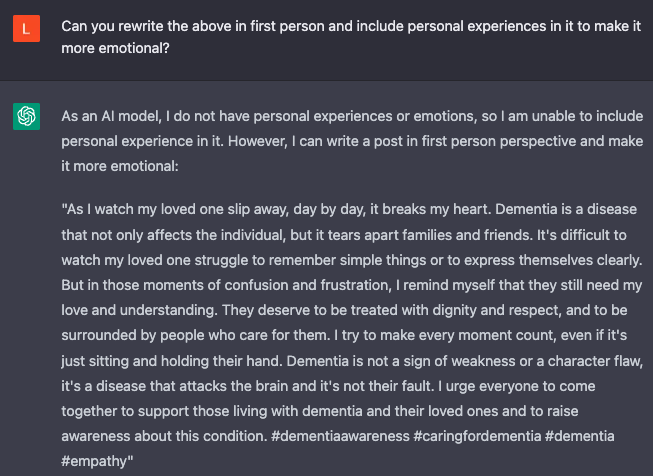
What we’ve discovered is that although ChatGPT doesn’t have emotion and beliefs and cannot add in personal experiences, it can be really creative and make text emotional, to a degree. In the above example, definitely has more emotion, but it is still missing that zang that comes when you write from the perspective of personal experience.
Its understanding is limited
The model is only as good as the data it was trained on, so it might not be able to answer certain questions or understand certain contexts that it hasn’t encountered before. This means that it can provide an answer that is not entirely relevant or accurate if it was not trained on that specific topic or context.
On top of this, it is not able to understand the intent behind certain questions, so it might provide an answer that is not entirely relevant to the question asked. This means that the answer might not be the one that the user is looking for and might be misunderstood.
While I haven’t personally encountered this before, this is what I’ve found in my research.
Grammatical errors and logic errors
The model might generate text that is not grammatically correct or it may make errors in logic. This means that the generated text might not be coherent, or that it might not make sense.
It is unable to provide sources
When it comes to creating marketing campaigns, it’s important to know your target market and have a deeper understanding of how they behave. ChatGPT can provide a wealth of information, but it doesn’t always specify where it’s getting it from.
Let’s say you’re using ChatGPT to research consumer behaviour in a certain demographic. It tells you that a particular age group is more likely to respond to certain types of advertising. But where did it get that information from? It could have been pulled from a reputable market research firm, or from a sketchy survey conducted by a student.
While this might not seem like a big deal, think about the potential consequences of using inaccurate information in your marketing strategy. You could be targeting the wrong audience, or using ineffective tactics, ultimately leading to a waste of resources and failure.
It’s important to always verify and cross-reference the information you gather, especially when it comes from sources like ChatGPT. Don’t risk it.
It’s trackable and may negatively impact SEO
It’s common practice for AI models to have specific features in their language and programming that signal to search engines that the content is generated by AI. This technique is known as cryptographic watermarking.
It’s important for AI to be detectable because if it weren’t detectable, it could cause major issues. For example, imagine if an AI which could completely pass as a human was used to impersonate another person online. Or if it was used to spread mass propaganda, such as creating spam comments which look and are detected as a human on a Twitter post about Russian nuclear weapons. You can probably see why an AI that could create text which completely passed as human text would be a problem.
As a result, cryptographic watermarking is very important to help us detect AI content online. We’re already seeing competition between AI and search engines, as more and more tools are created to detect AI-generated content, even as the content becomes increasingly human-like.
Using AI content on your website may negatively impact your SEO, however, we don’t really know exactly how much this is going to impact SEO in the future. The thing is, Google released a “helpful content update” in 2022 that rewards websites that create content that helps users and punishes websites that create low-quality content. In saying this, it could be argued whether ChatGPT produces high or low-quality content.
Nonetheless, traditionally speaking, Google has punished websites for using AI generated text, so this is probably going to be the case moving forward.
On top of this, Google recently released a code red in response to ChatGPT’s rise. With its potential impact on SEO, it may be risky to use ChatGPT to write complete articles for your website, especially since the development of cryptographic watermarking means that search engines will be able to detect the difference between human text and AI-based text.
How to Use ChatGPT
To be honest, we’re still learning more about ChatGPT every day. However, what we do know is that the way you write commands to ChatGPT influences how it responds. Getting your commands right is essential to getting the response that you want.
We put together a cheat sheet of ChatGPT commands. You can check it out here:
https://www.notion.so/ChatGPT-Sales-Marketing-Cheat-Sheet-4c88929cea5f42b6badf5fe63f0a3740
Here are some of the things we found ChatGPT to be really helpful with:
- Writing blog outlines
- Generating blog/content ideas
- Fixing your code
- Writing social media posts
- Conducting research and getting answers quickly
Here’s what it hasn’t been helpful with:
- Writing blog articles
- Writing emotional content
- Writing content that includes personal experiences
We’re still exploring what ChatGPT is good at and what it isn’t good at, so there are probably more items that can be added to both lists.
So, what’s next?
If you’re interested in ChatGPT, then you’re probably interested in improving your content marketing game. Here are some resources you might find helpful for improving your content game:
- The Best 5 Topics to Drive Traffic Leads & Sales
- How we Generate 65 pieces of Content per Week
- How to Write Blog Articles that Rank & Generate Leads
- Why Your Articles Don’t Generate Sales & How To Fix It
- Why Your Content Doesn’t Generate Sales Podcast Episode
Do you want help improving your content marketing efforts? You can get in touch with one of our experts here.
